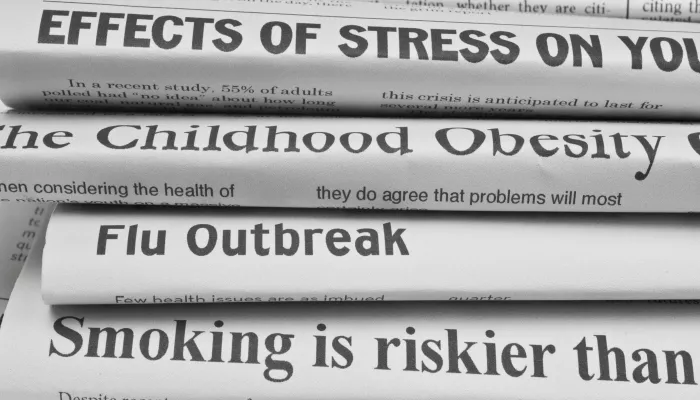And one-third of young adults are at risk of becoming diabetic
Nearly half of California adults, including one out of every three young adults, have either prediabetes — a precursor to type 2 diabetes — or undiagnosed diabetes, according to a UCLA study released today. The research provides the first analysis and breakdown of California prediabetes rates by county, age and ethnicity, and offers alarming insights into the future of the nation’s diabetes epidemic.
Conducted by the UCLA Center for Health Policy Research and commissioned by the California Center for Public Health Advocacy, the study analyzed hemoglobin A1c and fasting plasma glucose findings from the National Health and Nutrition Examination Survey together with California Health Interview Survey data from over 40,000 respondents.
The study estimates that some 13 million adults in California, or 46 percent, have prediabetes or undiagnosed diabetes, while another 2.5 million adults, or 9 percent, have already been diagnosed with diabetes. Combined, the two groups represent 15.5 million people — 55 percent of the state’s population. Because diabetes is more common among older adults, the study’s finding that 33 percent of young adults aged 18 to 39 have prediabetes is of particular concern.
“This is the clearest indication to date that the diabetes epidemic is out of control and getting worse,” says Dr. Harold Goldstein, executive director of the health advocacy center. “With limited availability of healthy food in low-income communities, a preponderance of soda and junk food marketing, and urban neighborhoods lacking safe places to play, we have created a world where diabetes is the natural consequence. If there is any hope to keep health insurance costs from skyrocketing, health care providers from being overwhelmed and millions of Californians from suffering needlessly from amputations, blindness and kidney failure, the state of California must launch a major campaign to turn around the epidemic of type 2 diabetes.”
County-by-County Crisis
The study estimates prediabetes rates by county, finding major disparities across the state, particularly among those aged 18 to 39. For those young adults, prediabetes rates ranged from lows of 26 percent in Lake County and 28 percent in San Francisco County to a high of 40 percent in rural Kings County and Imperial County. Racial and ethnic disparities are extremely pronounced. There are statistically higher prediabetes rates among young adult Pacific Islanders (43 percent), African Americans (38 percent), American Indians (38 percent), multiracial Californians (37 percent), Latinos (36 percent) and Asian Americans (31 percent) than among white young adults (29 percent), pointing to the need to focus additional prevention efforts in those communities. No demographic or region appeared to be free of the diabetes and prediabetes epidemics, as outlined in the policy brief. Complicating matters is the fact that many people do not get tested for prediabetes because the test often is not covered by insurance, particularly for those under the age of 45. And although there are effective interventions to help people control their weight and adopt a healthier lifestyle, these programs are often not be covered by insurers.
“There are significant barriers not only to people knowing their status, but getting effective help,” said Dr. Susan Babey, lead author of the study and co-director of the UCLA Center for Health Policy Research’s Chronic Disease Program. “A simple blood test for diabetes should be covered by all insurers, as should the resources and programs that can make a real difference in stopping the progression of this terrible disease.”
Prevention is Possible
Prediabetes is a condition in which blood glucose levels are higher than normal but not high enough for a diabetes diagnosis. Up to 30 percent of people with prediabetes will develop type 2 diabetes within five years, and as many as 70 percent of them will develop the disease in their lifetime. Diabetes is associated with dramatically increased risk of amputation, nerve damage, blindness, kidney disease, heart disease, hospitalization and premature death.
Diabetes is one of America’s fastest-growing diseases and one of the most costly. Nationally, diabetes rates have tripled over the past 30 years. In California, the rate has increased by 35 percent since 2001. Nationally, annual medical spending for people with diabetes is almost twice that for people without diabetes. A person who is diagnosed with diabetes by age 40 will have lifetime medical spending that is $124,600 more than someone who is not.
Three-quarters of that care is paid through Medicare and Medi-Cal, including $254 million in annual hospital costs that are paid by Medi-Cal alone.
To avoid the progression from prediabetes to diabetes, the study’s authors recommend greater participation in the National Diabetes Prevention Program, as well as policy and other changes to increase screening and prevention and encourage healthy, active lifestyles.
“For most people, type 2 diabetes is entirely preventable,” Dr. Goldstein said. “If Medi-Cal covered diabetes prevention programs and every health provider screened for prediabetes, we could prevent a large proportion of cases. In exchange for a proactive investment today, we can save billions of dollars in health care costs over the next five years and beyond, and save thousands of lives.” Read the study: Prediabetes in California: Nearly Half of California Adults on Path to Diabetes
The study was funded by the California Health Care Foundation and The California Endowment. Recommendations and materials are available at www.caprediabetes.org.
About the UCLA Center for Health Policy Research
The UCLA Center for Health Policy Research (CHPR) is one of the nation’s leading health policy research centers and the premier source of health policy information for California. UCLA CHPR improves the public’s health through high quality, objective, and evidence-based research and data that informs effective policymaking. UCLA CHPR is the home of the California Health Interview Survey (CHIS) and is part of the UCLA Fielding School of Public Health. For more information, visit healthpolicy.ucla.edu.




